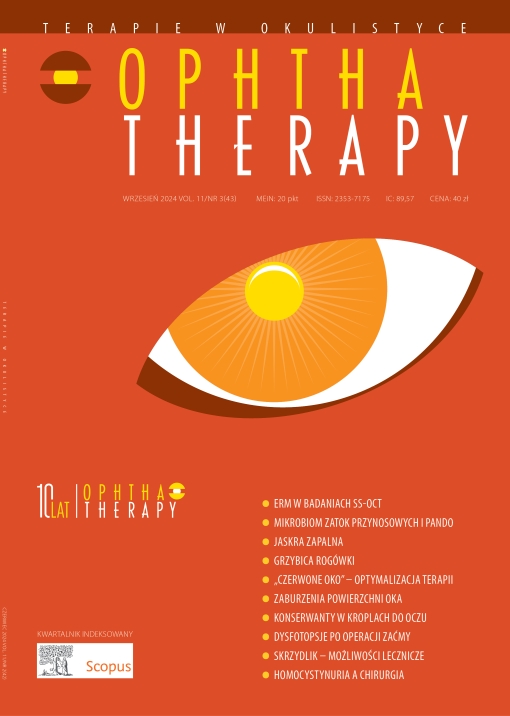Treatment of Acremonium sp. keratomycosis – a review of literature Artykuł przeglądowy
##plugins.themes.bootstrap3.article.main##
Abstrakt
Corneal infections may be caused by bacteria, viruses, fungi or protozoa. Fungal keratitis, usually associated with Fusarium, Candida and Aspergillus, develops from a saprophytic fungal infection as well, one of the agent being Acremonium sp. Acremonium infection occurs when a patient is suffering from a penetrating injury, common in ophthalmic patients. Symptoms of Acremonium- induced keratomycosis are similar to the usual presentation of a fungal infection – patients complain of decreased visual acuity, ocular pain, redness of the eye, floaters and corneal opacity. While there is no established method of treatment for Acremonium keratitis, usual antimycotics and antibiotics intended for keratomycosis are used – fluoroquinolones, azoles and polyenes. If pharmacotherapy does not yield favorable outcomes, surgical forms of treatment should be introduced, such as keratoplasty. If surgical methods are ineffective in infection control, an end-stage solution – enucleation is employed. Although Acremonium is an opportunistic fungal pathogen, the infection is generally effectively treated using pharmacotherapy.
Pobrania
##plugins.themes.bootstrap3.article.details##

Utwór dostępny jest na licencji Creative Commons Uznanie autorstwa – Użycie niekomercyjne – Bez utworów zależnych 4.0 Międzynarodowe.
Copyright: © Medical Education sp. z o.o. License allowing third parties to copy and redistribute the material in any medium or format and to remix, transform, and build upon the material, provided the original work is properly cited and states its license.
Address reprint requests to: Medical Education, Marcin Kuźma (marcin.kuzma@mededu.pl)
Bibliografia
2. Gurnani B, Kaur K. Bacterial Keratitis. StatPearls Publishing, Treasure Island (FL) 2023. https://www.ncbi.nlm.nih.gov/books/NBK574509/.
3. Koganti R, Yadavalli T, Naqvi RA et al. Pathobiology and treatment of viral keratitis. Exp Eye Res. 2021; 205: 108483. https://doi.org/10.1016/j.exer.2021.108483.
4. Cabrera-Aguas M, Khoo P, Watson SL. Infectious keratitis: A review. Clin Exp Ophthalmol. 2022; 50: 543-562. https://doi.org/10.1111/ceo.14113.
5. Lorenzo-Morales J, Khan NA, Walochnik J. An update on Acanthamoeba keratitis: diagnosis, pathogenesis and treatment. Parasite. 2015; 22: 10. https://doi.org/10.1051/parasite/2015010.
6. Lakhundi S, Siddiqui R, Khan NA. Pathogenesis of microbial keratitis. Microb Pathog. 2017; 104: 97-109. https://doi.org/10.1016/j.micpath.2016.12.013.
7. Ting DSJ, Ho CS, Deshmukh R et al. Infectious keratitis: an update on epidemiology, causative microorganisms, risk factors, and antimicrobial resistance. Eye. 2021; 35: 1084-101. https://doi.org/10.1038/s41433-020-01339-3.
8. Wu YT, Willcox M, Zhu H et al. Contact lens hygiene compliance and lens case contamination: A review. Cont Lens Anterior Eye. 2015; 38: 307-16. https://doi.org/10.1016/j.clae.2015.04.007.
10. Das S, Saha R, Dar SA et al. Acremonium species: a review of the etiological agents of emerging hyalohyphomycosis. Mycopathologia. 2010; 170: 361-75. https://doi.org/10.1007/s11046-010-9334-1.
11. Priyadarshini SR, Soni T, Sahu SK. et al. Acremonium keratitis: Risk factors, clinical characteristics, management, and outcome in 65 cases. Indian J Ophthalmol. 2022; 70: 3522-7. https://doi.org/10.4103/ijo.IJO_659_22.
13. Ou JI, Acharya NR. Epidemiology and treatment of fungal corneal ulcers. Int Ophthalmol Clin. 2007; 47: 7-16. https://doi.org/10.1097/IIO.0b013e318074e727.
15. Joe SG, Lim J, Lee JY et al. Case report of Acremonium intraocular infection after cataract extraction. Korean J Ophthalmol. 2010; 24: 119-22. https://doi.org/10.3341/kjo.2010.24.2.119.
17. Hotta F, Eguchi H, Nishimura K et al. A super-infection in the cornea caused by Stemphylium, Acremonium, and α-Streptococcus. Ann Clin Microbiol Antimicrob. 2017; 16: 11. https://doi.org/10.1186/s12941-017-0187-z.
18. Haddad RS, El-Mollayess GM. Combination of intracameral and intrastromal voriconazole in the treatment of recalcitrant Acremonium fungal keratitis. Middle East Afr J Ophthalmol. 2012; 19: 265-8. https://doi.org/10.4103/0974-9233.95271.
19. Aramă V. Topical antibiotic therapy in eye infections - myths and certainties in the era of bacterial resistance to antibiotics. Rom J Ophthalmol. 2020; 64: 245-260.
20. Matoba AY. Fungal keratitis responsive to moxifloxacin monotherapy. Cornea. 2012; 31: 1206-9. https://doi.org/10.1097/ICO.0b013e31823f766c .
21. Cai J, Yang C, Wei Q et al. Natamycin versus natamycin combined with voriconazole in the treatment of fungal keratitis. Pak J Med Sci. 2023; 39: 775-9. https://doi.org/10.12669/pjms.39.3.6908.
22. Qiu S, Zhao GQ, Lin J, Wang X et al. Natamycin in the treatment of fungal keratitis: a systematic review and Meta-analysis. Int J Ophthalmol. 2015; 8: 597-602. https://doi.org/10.3980/j.issn.2222-3959.2015.03.29.
23. Hoffman JJ, Yadav R, Sanyam SD et al. Topical Chlorhexidine 0.2% versus Topical Natamycin 5% for the Treatment of Fungal Keratitis in Nepal: A Randomized Controlled Noninferiority Trial. Ophthalmology. 2022; 129: 530-41. https://doi.org/10.1016/j.ophtha.2021.12.004.
24. Noor A, Preuss CV. Amphotericin B. StatPearls Publishing, Treasure Island (FL) 2023. https://www.ncbi.nlm.nih.gov/books/NBK482327/.
25. Raj N, Vanathi M, Ahmed NH et al. Recent Perspectives in the Management of Fungal Keratitis. J Fungi (Basel). 2021; 7: 907. https://doi.org/10.3390/jof7110907.
26. Lakhani P, Patil A, Majumdar S. Challenges in the Polyene- and Azole-Based Pharmacotherapy of Ocular Fungal Infections. J Ocul Pharmacol Ther. 2019; 35: 6-22. https://doi.org/10.1089/jop.2018.0089.
27. Mahmoudi S, Masoomi A, Ahmadikia K et al. Fungal keratitis: An overview of clinical and laboratory aspects. Mycoses. 2018; 61: 916-30. https://doi.org/10.1111/myc.12822.
28. Nejabat M, Yaqubi N, Khosravi A et al. Therapeutic Effect of Intrastromal Voriconazole, Topical Voriconazole, and Topical Natamycin on Fusarium Keratitis in Rabbit. J Ophthalmol. 2016; 2016: 8692830. https://doi.org/10.1155/2016/8692830.
29. Gurnani B, Kaur K. Therapeutic Keratoplasty. StatPearls Publishing, Treasure Island (FL) 2023. https://www.ncbi.nlm.nih.gov/books/NBK592415/.
31. Veugen JMJ, Dunker SL, Wolffs PFG et al. Corneal Transplantation for Infectious Keratitis: A Prospective Dutch Registry Study. Cornea. 2023; 42: 1414–21. https://doi.org/10.1097/ICO.0000000000003218.
32. Palioura S, Henry CR, Amescua G et al. Role of steroids in the treatment of bacterial keratitis. Clin Ophthalmol. 2016; 10: 179-86. https://doi.org/10.2147/OPTH.S80411.
33. Stamate AC, Tătaru CP, Zemba M. Emergency penetrating keratoplasty in corneal perforations. Rom J Ophthalmol. 2018; 62: 253-9. https://www.ncbi.nlm.nih.gov/pmc/articles/PMC6421488/.
34. Barut Selver O, Egrilmez S, Palamar M et al. Therapeutic Corneal Transplant for Fungal Keratitis Refractory to Medical Therapy. Exp Clin Transplant. 2015; 13: 355-9. https://doi.org/10.6002/ect.2014.0108.
35. Sridhar U, Tripathy K. Amniotic Membrane Graft. StatPearls Publishing, Treasure Island (FL) 2023. https://www.ncbi.nlm.nih.gov/books/NBK567771/.
36. Jirsova K, Jones GLA. Amniotic membrane in ophthalmology: properties, preparation, storage and indications for grafting-a review. Cell Tissue Bank. 2017; 18: 193-204. https://doi.org/10.1007/s10561-017-9618-5.
37. Chen HC, Tan HY, Hsiao CH et al. Amniotic membrane transplantation for persistent corneal ulcers and perforations in acute fungal keratitis. Cornea. 2006; 25: 564-72. https://doi.org/10.1097/01.ico.0000227885.19124.6f.
38. Tóth G, Pluzsik MT, Csákány B et al. Clinical Review of Ocular Traumas Resulting in Enucleation or Evisceration in a Tertiary Eye Care Center in Hungary. J Ophthalmol. 2021; 2021: 5588977. https://doi.org/10.1155/2021/5588977.
39. Soares IP, França VP. Evisceration and enucleation. Semin Ophthalmol. 2010; 25: 94-7. https://doi.org/10.3109/08820538.2010.488575.
40. Tóth G, Pluzsik MT, Sándor GL et al. Clinical Review of Microbial Corneal Ulcers Resulting in Enucleation and Evisceration in a Tertiary Eye Care Center in Hungary. J Ophthalmol. 2020; 2020: 8283131. https://doi.org/10.1155/2020/8283131.

